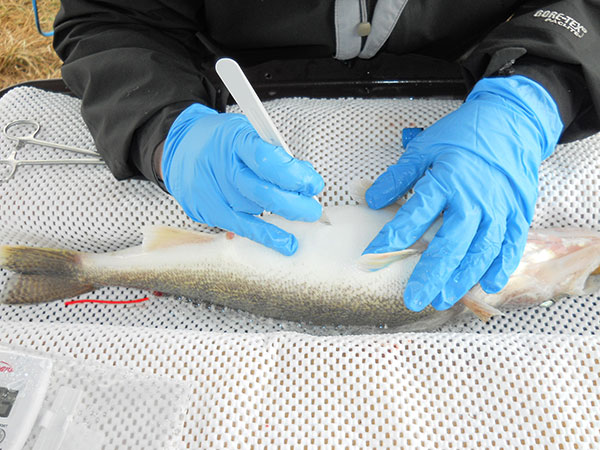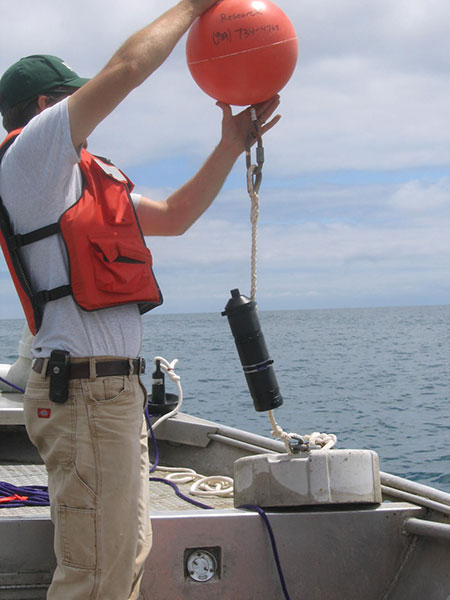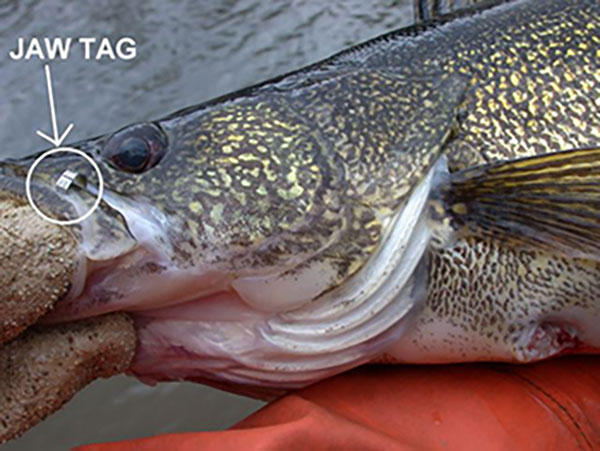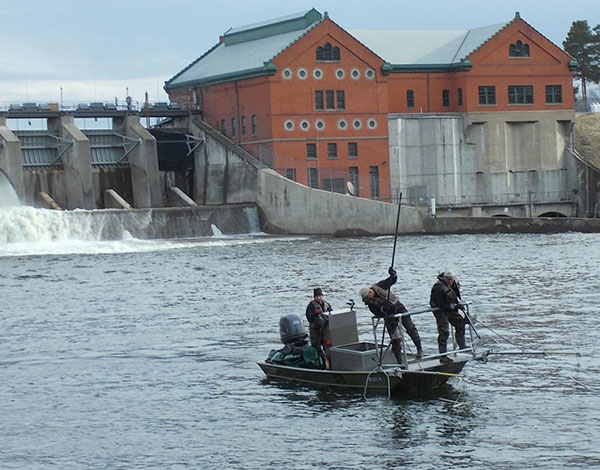- Details
MDNR Report
 Transmitter being implanted in walleye
Transmitter being implanted in walleye
A new study begins this month on Saginaw Bay, using acoustic transmitters that will be implanted in walleye to help researchers with the Michigan DNR, Michigan State University and several partner agencies obtain data about where the fish spawn.
 Acoustical receiver for tracking walleyeFish in such telemetry projects have acoustic transmitters affixed to them. Each transmitter then beeps a fish-specific code every few minutes. Acoustic receivers deployed in Lake Huron decode the tag beeps and log when fish tags are detected. The network of acoustic receivers in Saginaw Bay includes receivers in the mouths of rivers to listen for tagged fish moving to spawning grounds and receivers in Saginaw Bay to determine where walleye may be spawning.
Acoustical receiver for tracking walleyeFish in such telemetry projects have acoustic transmitters affixed to them. Each transmitter then beeps a fish-specific code every few minutes. Acoustic receivers deployed in Lake Huron decode the tag beeps and log when fish tags are detected. The network of acoustic receivers in Saginaw Bay includes receivers in the mouths of rivers to listen for tagged fish moving to spawning grounds and receivers in Saginaw Bay to determine where walleye may be spawning.
Having a better understanding of relative sources of natural reproduction for walleye will help fishery managers determine which rivers and reefs to protect and, when needed, where to invest in actions that enhance and improve fish habitat.
- Details
MDNR Report
 Walleye with Jaw Tag
Walleye with Jaw Tag
The MDNR began to jaw tag 3,000 walleye across multiple Saginaw Bay tributary rivers the last week of March. As the DNR adds more tagged walleye to Michigan waters, anglers are asked to report tagged fish to assist data collection efforts.
Anyone catching a tagged fish is asked to report the following information using the tag return form at Michigan.gov/EyesInTheField:
- Species
- Length
- Weight (if known)
- Tag location (where tag was attached)
- Identification number (the larger of the two sets of numbers)
- Tag return address (for example MICH DNR MM-1)
- Capture date and location
- Details
MDNR Report
 Croton Dam
Croton Dam
Muskegon River anglers should be on the lookout for Michigan Department of Natural Resources personnel collecting walleye eggs below Croton Dam this spring.
Walleye will be collected with electrofishing boats through late March and to April 14. The date these collections begin will depend on water temperatures, the presence of ripe fish and other factors. It is anticipated most work will be completed from the last week of March through the first week of April. Five days of electrofishing are planned, with four of those being egg-take days.
"This adult population consists of mostly stocked fish," said Ed Pearce, DNR fisheries technician supervisor who coordinates the egg take. "The Muskegon River has the largest run of walleye in the Lake Michigan watershed south of Green Bay."
- Details
By Louie Stout
 Walleye Stocking
Walleye Stocking
The St. Joseph River walleye stocking program got another boost last month, thanks to the efforts of the Michiana Walleye Association (MWA) and the Indiana DNR.
Some 12,000 6- to 8-inch walleyes were stocked at Maggies Landing in Mishawaka. The fish were raised by Gollon Bait and Fish Farm in Wisconsin.
The DNR purchased 10,000 of those while the Michiana Walleye Club, which has been the driving force in Indiana’s St. Joseph River stocking since 1995, purchased the other 2,000.
The club pays for the fish through its fund-raisers held at the club grounds and donations it receives from individual anglers and businesses.
The walleyes are stocked every other year. According to Indiana DNR officials, the survival rate of those fish stocked is estimated to be around 34 percent.
Barry Ukele, a MWA founder and spearhead for the stocking program, said this year’s fish appeared to be in great shape and should contribute to the fishery in the years to come.
The St. Joe has become a viable walleye fishery since the mid-1990s. Catching big walleyes there can be tricky, but surveys show they are there.
Anglers who catch the young walleye over the upcoming months are urged to handle them with care and return them to the water quickly.





